Change nameservers to set up Office 365 with Asia Registry
Check the Domains FAQ if you don't find what you're looking for.
Follow these instructions if you want Office 365 to manage your Office 365 DNS records for you. (If you prefer, you can manage all your Office 365 DNS records at Asia Registry.)
Here's what you need to do. (Need more help? Get support.)
Add a TXT record for verification
Before you use your domain with Office 365, we have to make sure that you own it. Your ability to log in to your account at your domain registrar and create the DNS record proves to Office 365 that you own the domain.
Note: This record is used only to verify that you own your domain; it doesn't affect anything else. You can delete it later, if you like.
-
To get started, go to your domains page at Asia Registry by using this link. You'll be prompted to login first.
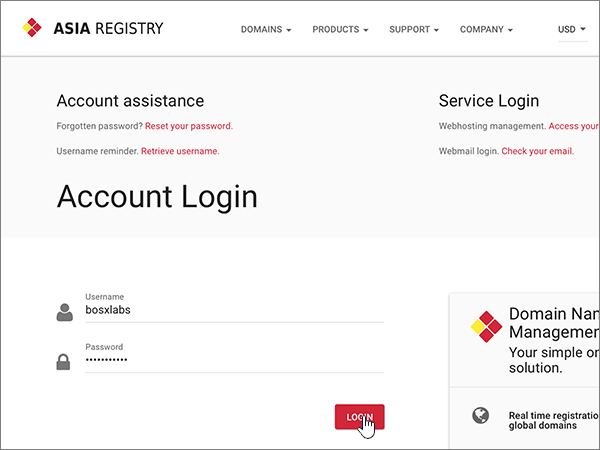
-
On the Dashboard page, choose MY DOMAINS.
(You may have to scroll down.)
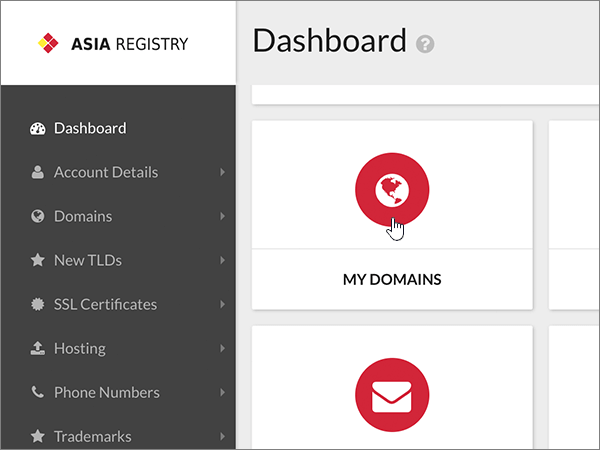
-
On the My Domains page, in the row for the domain you're changing, choose the domain name.
(You may have to scroll down.)
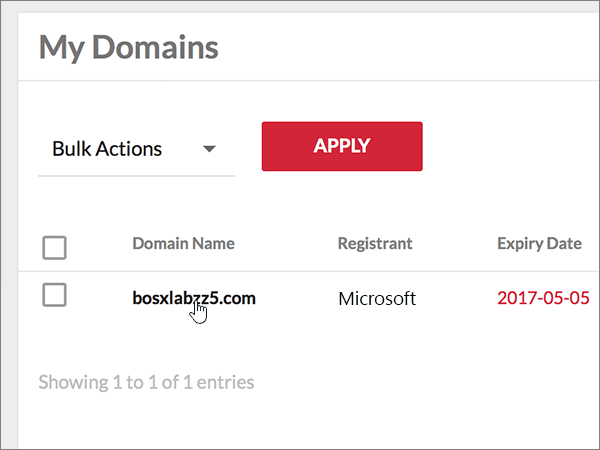
-
On the Domain Info page, choose DNS SETTINGS.
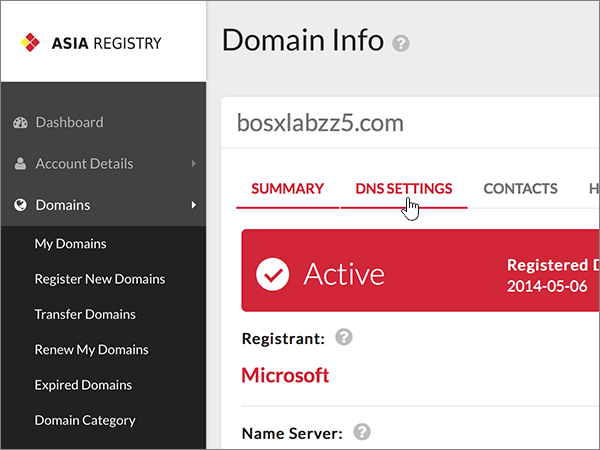
-
Select Use Asia Registry Name Servers.
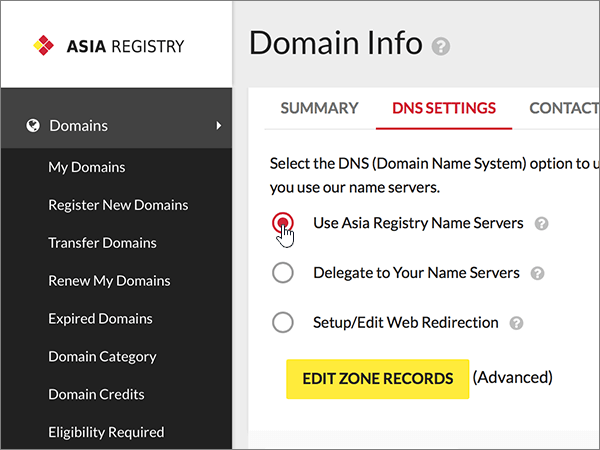
-
Choose EDIT ZONE RECORDS (Advanced).
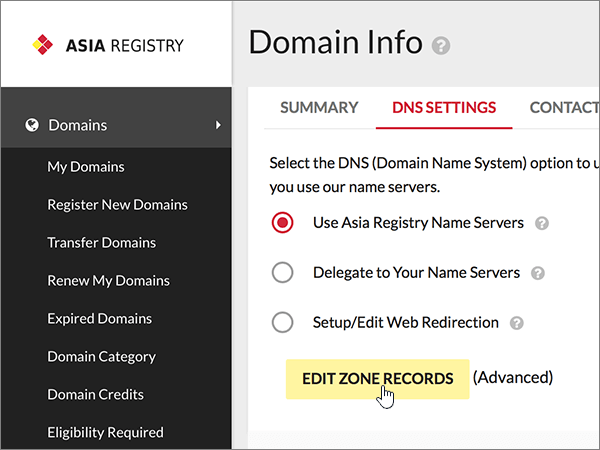
-
In the ZONE RECORDS section, in the boxes for the new record, type or copy and paste the values from the following table.
(Select the Type value from the drop-down list.)
Host
Type
Content
@
TXT
MS=msXXXXXXXX
Note: This is an example. Use your specific Destination or Points to Address value here, from the table in Office 365.
How do I find this?
-
Choose ADD to save the record, which also automatically adds a new empty row.
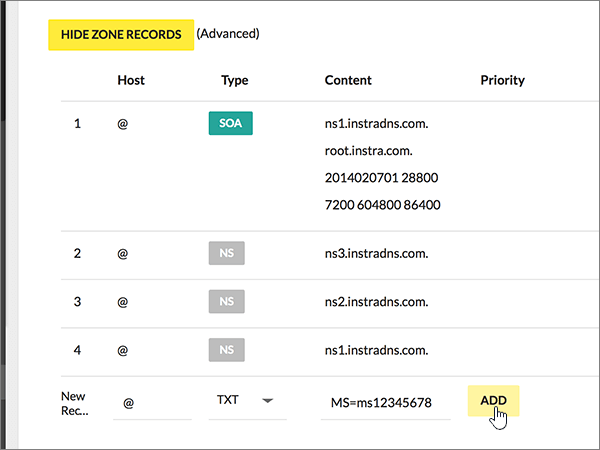
-
Wait a few minutes before you continue, so that the record you just created can update across the Internet.
Now that you've added the record at your domain registrar's site, you'll go back to Office 365 and request Office 365 to look for the record.
When Office 365 finds the correct TXT record, your domain is verified.
-
Choose Setup > Domains.
-
On the Domains page, choose the domain that you are verifying.
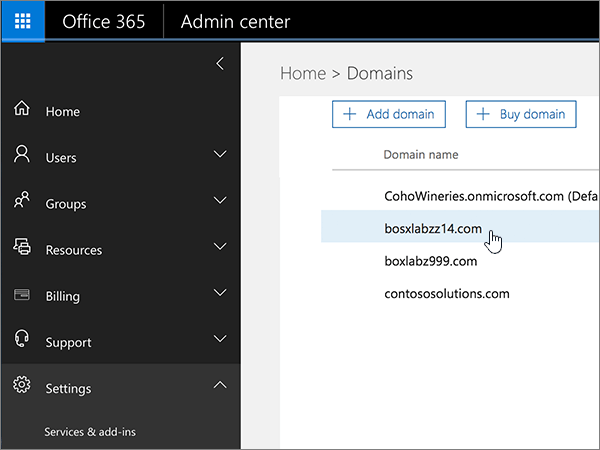
-
On the Setup page, choose Start setup.
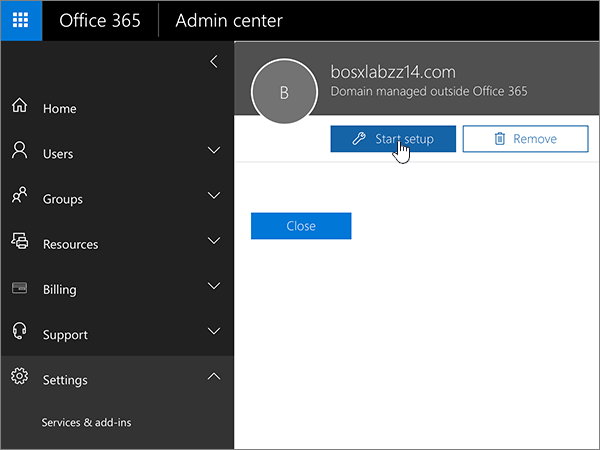
-
On the Verify domain page, choose Verify.
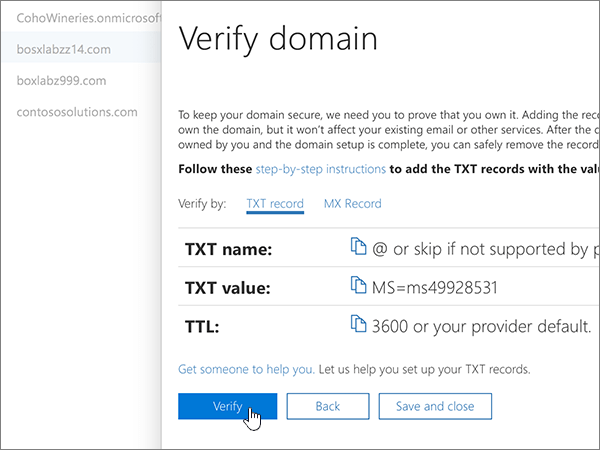
Note: Typically it takes about 15 minutes for DNS changes to take effect. However, it can occasionally take longer for a change you've made to update across the Internet's DNS system. If you're having trouble with mail flow or other issues after adding DNS records, see Troubleshoot issues after changing your domain name or DNS records.
Change your domain's nameserver (NS) records
To complete setting up your domain with Office 365, you change your domain's NS records at your domain registrar to point to the Office 365 primary and secondary name servers. This sets up Office 365 to update the domain's DNS records for you. We'll add all records so that email, Skype for Business Online, and your public website work with your domain, and you'll be all set.
Caution: When you change your domain's NS records to point to the Office 365 name servers, all the services that are currently associated with your domain are affected. For example, all email sent to your domain (like rob@your_domain.com) will start coming to Office 365 after you make this change.
Important:
-
When you have completed the steps in this section, the only nameservers that should be listed are these four:
-
The following procedure will show you how to delete any other, unwanted nameservers from the list, and also how to add the correct nameservers if they are not already in the list.
-
ns1.bdm.microsoftonline.com
-
ns2.bdm.microsoftonline.com
-
ns3.bdm.microsoftonline.com
-
ns4.bdm.microsoftonline.com
-
To get started, go to your domains page at Asia Registry by using this link. You'll be prompted to login first.

-
On the Dashboard page, choose MY DOMAINS.
(You may have to scroll down.)

-
On the Domain Info page, in the Name Server section, choose EDIT.
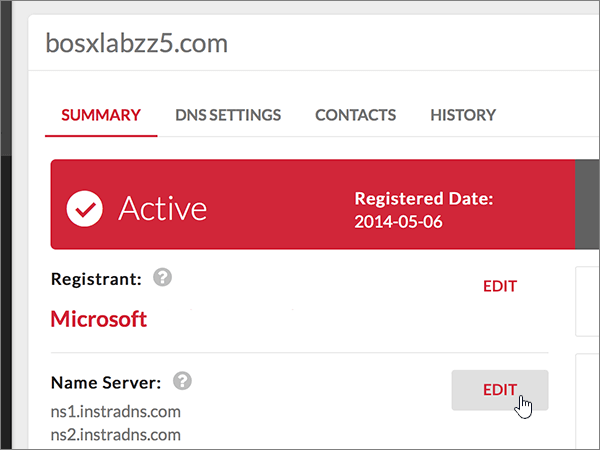
-
Select Delegate to Your Name Servers.
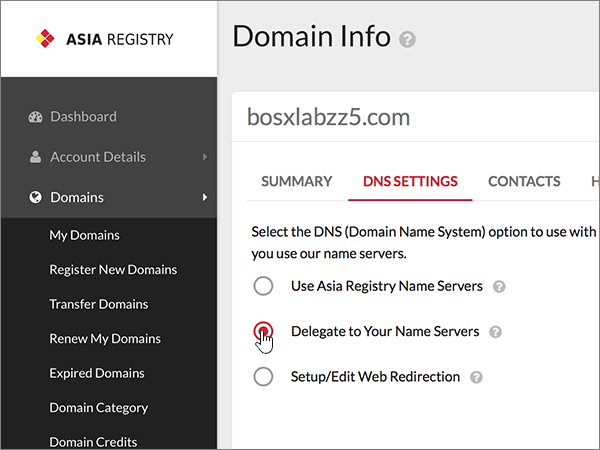
-
Depending on whether or not there are already nameservers listed on the page that is displayed now, continue to one of the two following procedures:
-
If there are NO nameservers already listed, go to the first procedure.
-
If there ARE nameservers already listed, go to the second procedure.
-
If there are NO nameservers already listed
-
In the Host Name area, type or copy and paste the Host Name values from the following table.
Host Name
IP Address
ns1.bdm.microsoftonline.com
(Leave this field empty.)
ns2.bdm.microsoftonline.com
(Leave this field empty.)
ns3.bdm.microsoftonline.com
(Leave this field empty.)
ns4.bdm.microsoftonline.com
(Leave this field empty.)
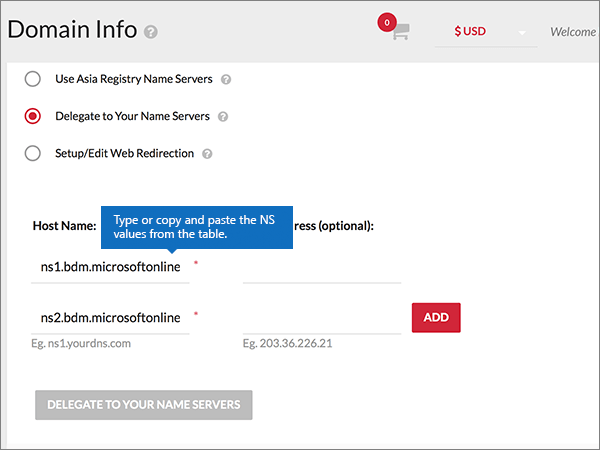
-
Add the other two Name Server values.
Choose ADD and then type or copy and paste the value from the next row of the table into the box for the record.
Repeat this process until you have created all four Nameserver records.
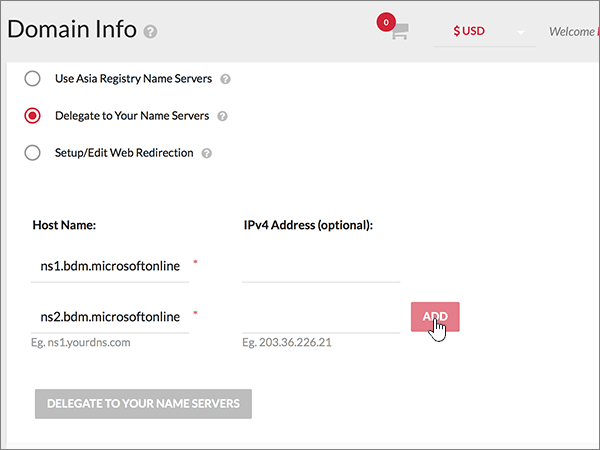
-
Choose DELEGATE TO YOUR NAME SERVERS.
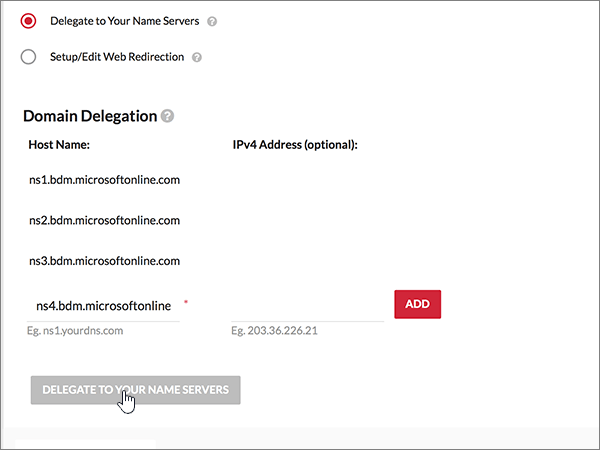
Note: Your nameserver record updates may take up to several hours to update across the Internet's DNS system. Then your Office 365 email and other services will be all set to work with your domain.
If there ARE nameservers already listed
Caution: Follow these steps only if you have existing nameservers other than the four correct nameservers. (That is, delete only any current nameservers that are not named ns1.bdm.microsoftonline.com, ns2.bdm.microsoftonline.com, ns3.bdm.microsoftonline.com, or ns4.bdm.microsoftonline.com.)
-
If there are any other nameservers listed, choose the Edit icon for each one to update that nameserver.
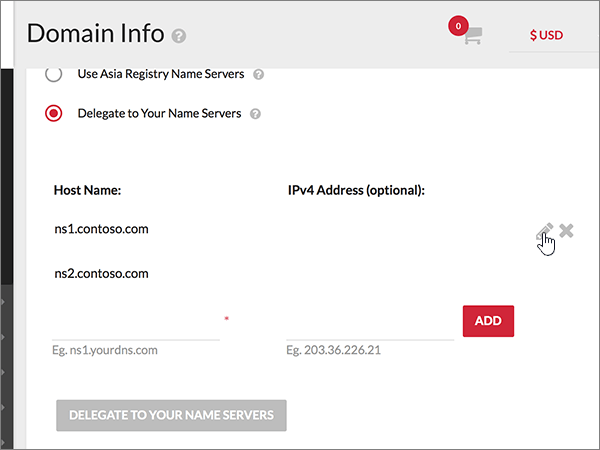
-
In the Host Name area, delete each nameserver entry by selecting that entry and then pressing the Delete key on your keyboard.
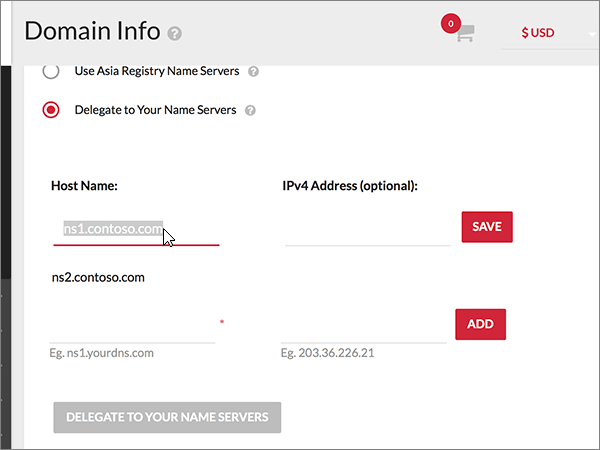
-
Add the first nameserver.
Still in the Host Name area, type or copy and paste the first Host Name value from the following table.
Host Name
IP Address
ns1.bdm.microsoftonline.com
(Leave this field empty.)
ns2.bdm.microsoftonline.com
(Leave this field empty.)
ns3.bdm.microsoftonline.com
(Leave this field empty.)
ns4.bdm.microsoftonline.com
(Leave this field empty.)
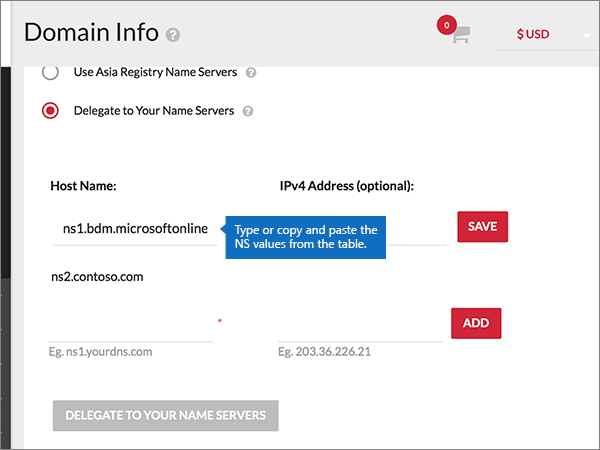
-
Choose SAVE.
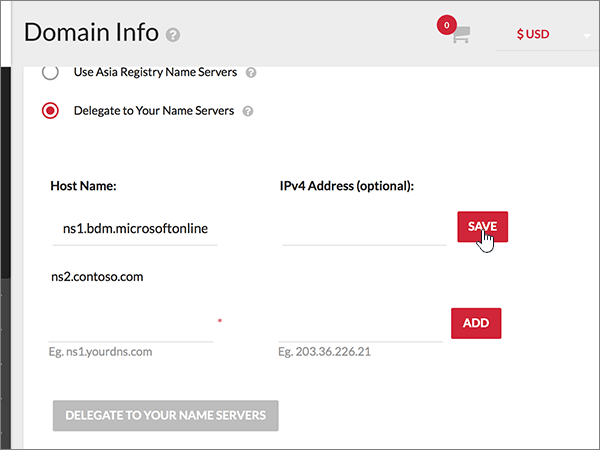
-
Add the second nameserver record.
Still in the Host Name area, choose the Edit icon to update the other record using the values from the second row in the table, and then again choose SAVE to complete that record.
-
Add the other Name Server values.
Choose ADD and then type or copy and paste the value from the third row of the table above into the box for the next record. Repeat this process until you have created all four Nameserver records.
-
Delete any other incorrect nameservers by choosing the Edit icon, deleting each nameserver entry by selecting that entry and pressing the Delete key on your keyboard, and then choosing SAVE. When you are finished, you should have only four nameservers listed:
ns1.bdm.microsoftonline.com
ns2.bdm.microsoftonline.com
ns3.bdm.microsoftonline.com
ns4.bdm.microsoftonline.com
Note: Your nameserver record updates may take up to several hours to update across the Internet's DNS system. Then your Office 365 email and other services will be all set to work with your domain.
Still need help?




No comments:
Post a Comment